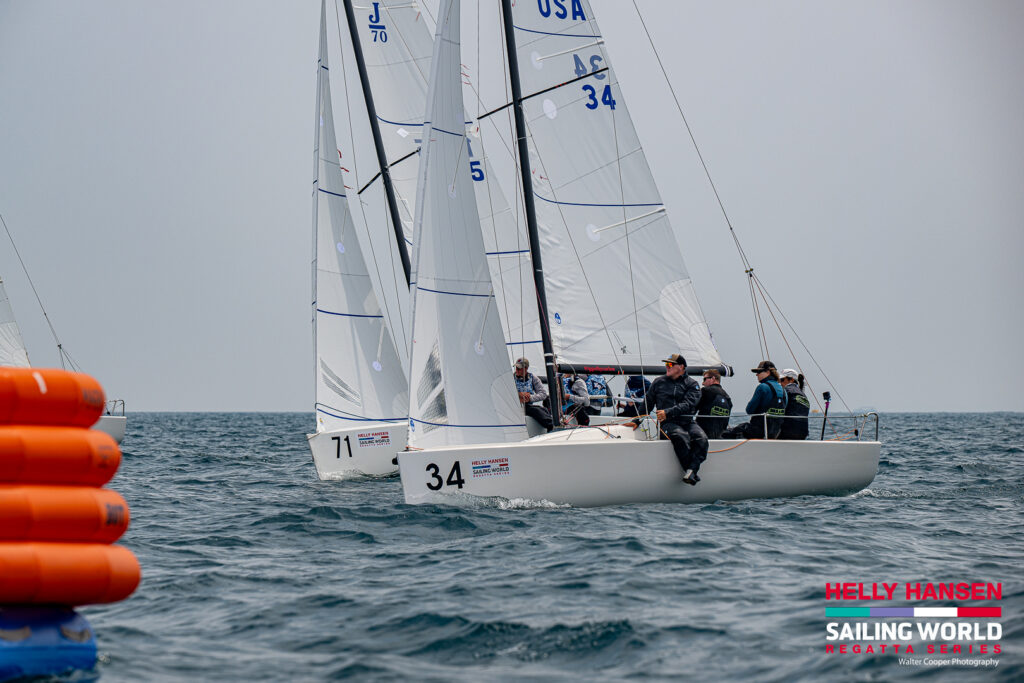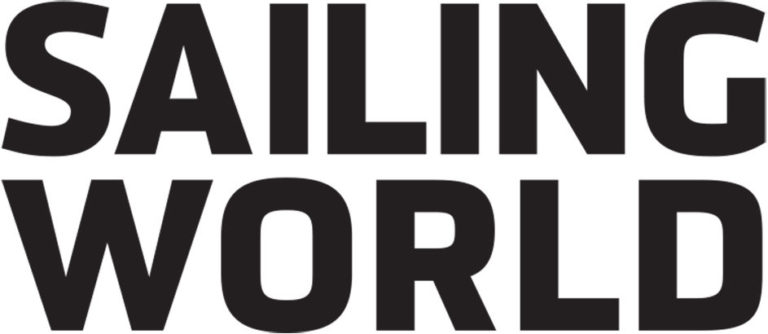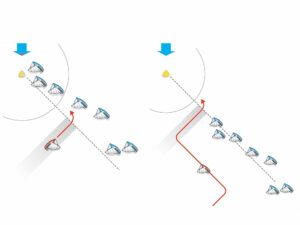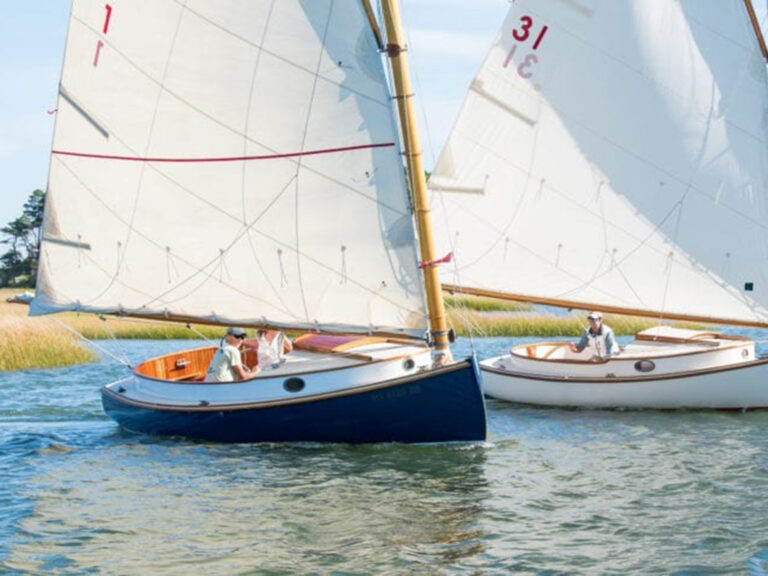
Making good use of an afternoon practice session ahead of the 2025 Helly Hansen Sailing World Regatta Series in Chicago in June—another step toward their goal of winning a J/70 world title, skipper Cate Terhune-Muller and her crew—husband Allan Terhune, tactician Steve Hunt and trimmer Nick Turney—are circling in the starting area on board the Terhune’s J/70 Casting Couch. This is the second practice start of the informal scrimmage, which will be followed by a short windward-leeward lap. Their intent is to win the pin, a high-risk move given the caliber of teams on the other boats.
“Let’s do a pin layline practice,” Hunt says to his teammates, his communication clear and focused. The pre-race ritual of testing angles and timing is critical—especially given that everyone is using GPS-based starting systems.
Turney takes a quick glance at his watch and says, “3:15.”
“Call pin lay, Alan,” Hunt says, his yes scanning for other boats positioning themselves and gauging their position relative to the pin-end bouy.
“Not there yet,” Terhune responds.
“3:10,” Turney updates the team.
The cadence and clarity of the pre-start conversation reflects the level of professionalism with the team and the hundreds of hours they’ve spent racing, training and deep debriefing with their all-star coach Chris Larson.
“Heading up here and tacking,” Hunt announces. “Barely there.”
With less than 2 minutes until the start, Casting Couch maneuvers into position. Another boat, Richard Witzel’s Rowdy, is lining up for a pin end start as well.
“Rowdy wants the pin,” Hunt says, telling Muller-Terhune to, “Let him go in front of you.”
The countdown continues as they make their final approach.
“One minute, 64 meters,” Turney calls out.
“If you overlap, go above,” Hunt instructs Muller-Terhune, who is focused on maintaining clean air and a strong position.
They double tack to position themselves to leeward of Rowdy, sails luffing to slow the boat. And as the seconds tick down, there’s a sudden urgency to Hunt’s calls.
“I think we’re in trouble here, guys,” He warns.
Turney jumps into the conversation with a countdown: “Ten, nine, eight…”
Their too advanced and Hunt quickly aborts the start, advising Muller-Terhune to jibe around the pin and clear themselves. They’re not alone: Over the VHF, the race committee reports that all boats are over early, except Rowdy.
Once underway, the crew transition smoothly into their upwind mindset. The J/70 is notoriously tricky in variable conditions—underpowered in light air but requiring depowering as soon as the wind reach 8 to 10 knots, but Casting Couch’s collective experience has them dialed in to the speed they need.
“Take a deep breath and go fast,” Hunt encourage his skipper as they tack back on to starboard and regroup.
“Little puff on,” says Turney, who is scanning the blue waters of Lake Michigan. The gusty northwesterly wind is blowing through Chicago’s concrete maze of buildings. “Little puff here in about three, two, one. Number is 040, 5.6 is the target.”
The crew constantly communicates about the wind pressure and their positioning on the racecourse relative to other boats. “Rowdy crossing your bow right now,” Hunt reports as they make their way up short beat. “Not bad,” Hunt adds, satisfied with their position despite having done two extra tacks after the start. For this practice session, teams have agreed to 270-degree penalties for any OCS starts, rather than boats returning to the line to restart.
Their upwind performance has them right back among the leaders—none of whom have done their penalty turns.
Before they approach the windward mark, the tactical discussion shift to their downwind strategy.
Just got a 10-degree header,” Hunt says as they reach the top of the course. “It’s probably a long bear-away set.”
“Forty-five seconds each way,” Terhune says. “Maybe it lasts 30.”
“I think it’s winging conditions, so let’s wing pretty early in the run and just wing the whole time—kite on port,” Hunt calls.
As the bow passes the mark and Muller-Terhune turns downwind and the spinnaker fills with a crisp snap of sailcloth.
“Got a kite,” Turney says, after quickly pulling the halyard and taking the spinnaker sheet from Terhune. “Mine.”
“Stay low, winging main shortly,” Hunt says as they turn downwind.
The run presents a new set of challenges, given the J/70 wasn’t intentionally designed to be a boat that’s winged downwind. The perfect technique is next-level boathandling, requiring constant adjustment and communication between trimmer and helm.
Winging is a tactical sailing technique that allows the boat to sail directly toward the leeward mark with less sailed distance by having the jib or spinnaker out opposite the mainsail, avoiding the main’s wind shadow.
In light winds, winging is less effective due to insufficient sail pressure, and in heavy winds, transitioning to planing is typically better. The crossover isn’t always obvious. The technique requires a clear wind lane to ensure the sail remains stable.
The strategic use of winging involves making decisions based on constantly changing wind conditions, fleet positioning, and mark proximity. It’s essential to adapt quickly to changing winging angles and assess when to shift modes, such as during a lift or a header or positioning with other boats.
Practicing winging involves refining communication and timing within the crew to switch modes swiftly and effectively. When done right, winging opens up tactical opportunities like cutting corners at marks, forcing competitors into difficult positions, and maximizing speed toward downwind gates or finishes.
“Does it feel a little light to wing maybe?” Hunt asks Turney, considering their options.
“Maybe it’s borderline winging. Yeah,” Turney agrees. “No lower Cate, going straight here.”
Their refined teamwork and technique are on full display as they navigate the short run to the finish, with Hunt watching behind, calling out waves and pumping opportunities and then looking forward to the find the leeward marks.
“See the gates? Probably 50-50,” he says, already planning their approach to the leeward gate even though they’re only halfway down the leg.
“One little pump,” Turney calls, feeling a slight pull on the spinnaker sheet in his hand. “No higher than that Cate, and a wave here. Three, two, one, flatten and pump. Good angle there.”
“Nice job,” Hunt replies.
As they approach the leeward gate, they need to choose which mark to round and what the best approach will be. “OK, nice lane here,” Hunt observes. “High wing is probably best. High wing right now. Looking at the gates.”
“Almost kicking a field goal,” Hunt says, referring to their position between the gate marks.
They continue their downwind run with fluid precision, constantly making small adjustments to waves, puffs and wind shifts. “Little righty here,” Turney tells Muller-Terhune, who responds with a small movement of the tiller extension laying in her lap.
“The high wing mode looks pretty good here,” Hunt confirms.
Setting up for a jibe near the bottom of the course, Hunt takes over the spinnaker sheet from Turney, who will focus on jibing the mainsail. They quickly talk through it beforehand to ensure they’re in sync. The main comes across, Hunt trims the spinnaker to the new exit angle and the two of them call out in unison, as if finishing each other’s sentences: “Two-one, flatten…and pump…”
Another flawless jibe, and they finish overlapped with several other boats.
For this practice session, the gates serve as the finish line and Casting Couch glides across the line with the leaders. A solid comeback, and possibly a race win had the race winners done their 270s, Hunt suggests.
The outcome of this 15-minute practice race confirms why Casting Couch is one of the top teams in the ultra-competitive J/70 scene. The crew’s ability to read the conditions, make quick tactical decisions, and execute maneuvers with precision had put them in a strong position. It’s also proof, that while everyone will have an OCS or second-row start at some point, the best teams put the mistake behind them and focus on advancing one boat, one puff, one pump and one good call at a time.









